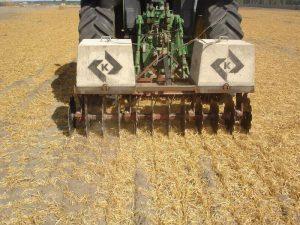Erosion control
Soil and surface stabilisation practicesDust control
What, why, when and issues to look out for
What
Dust control prevents soil particulate movement, especially on construction sites. Many of the soil management techniques covered elsewhere in this section can also be used specifically to control dust.
Why
Dust control prevents or reduces the movement of dust from disturbed soil surfaces that may create nuisance, health hazards, traffic safety problems and/or offsite damage and discharge to the environment.
Canterbury is especially prone to dust problems. Rain is infrequent, we experience many strong winds including the famous hot and dry nor’wester, and since the quakes we have had an increased number of road works and construction sites.
-
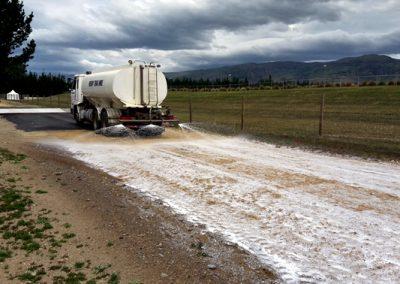
Dust suppression requires understanding the risks and the use of effective tools (Source: RST Solutions Limited).
-
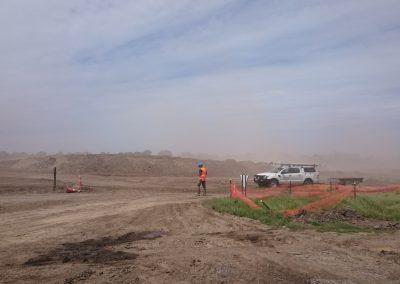
Poor practices can result in offensive dust discharge from development sites (Source: RST Solutions Limited).
-
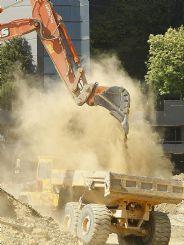
Poor practices can result in offensive dust discharge from development sites—bucket drop height.
When
Dust control is mainly used in areas subject to dust movement, eg open earthworks exposed to wind, stockpiles of materials, bulk materials handling and vehicle movements.
Issues to look out for
The effectiveness of dust control depends on moisture content and particle size of the soil or material, temperature, humidity and wind velocity/direction. Having enough water available is crucial to maintain the moisture content of surfaces and materials. Without that, you will need to use other methods to control dust.
Design essentials
Consider dust control early in the planning stages of any earthworks project. Forward planning and management to minimise dust problems are your best option. If dust management is only addressed after it has become a problem on site, it is very difficult to bring under effective control until the site has been stabilised.
This toolbox covers the following methods for dust control:
- Water sprinkling
- Mulching, grass establishment and gravelling (progressive stabilisation)
- Soil binders
- Geotextiles.
Soil binders
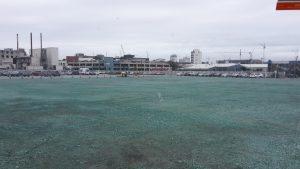
A large ex-demolition site that has been effectively stabilised to prevent offensive dust discharges during strong winds.
Soil binders are usually the most effective tool for controlling dust risk before vegetation is re-established, or the ground is consolidated. Check the guidance in the Soil Binders section for details on minimising dust discharges using these tools.
Water sprinkling
Water application is only marginally effective in Canterbury, especially over large areas of exposed soil. Long periods of easterly winds or gusty nor’westers often result in drying conditions that challenge the effectiveness of water sprinkling when used alone. Consider using additional tools to effectively control dust.
Even a simple change, such as adding wetting agents to water, will significantly increase its effectiveness. More tools are described below. Using water alone can impose significant financial and productivity costs to your project. For example, having a team member frequently driving a water cart around the site may not be the most productive use of their time, and it will use a lot of water inefficiently.
Water is applied via a water cart or sprinklers. Either system requires a minimum amount of water to achieve effective dust control. The Ministry for Environment’s (2001) Good Practice Guide for Assessing and Managing the Environmental Effects of Dust Emissions recommends that 1 litre/m²/hour (or 1 mm/m²/hour) of water is available. This is, however, generally considered conservative. The minimum amount of water that you should have available on site is 5 mm/m²/day. Apply it incrementally so the ground surface remains moist. Wetting agents will significantly increase the efficiency of water use.
Water carts can carry different volumes, but the vehicle has to be able to access the areas that require wetting.
You can also use a sprinkler system on large areas that are open or where the terrain is too steep for water carts. Sprinkler systems are also good when irrigation is needed to establish vegetation after the end of the earthworks.
You need a reliable and lawful source of water. This can be sourced from sediment retention ponds or authorised water takes (eg bore, stream, lake or municipal water supply). You will need to get approval from the district council to take from town supplies, so seek this in advance. Resource consent is needed for takes of water from bores, so again apply ahead of time, so that there is no delay in accessing a reliable supply for dust control.
You are responsible for have measures in place, so that dust control is effective.
-
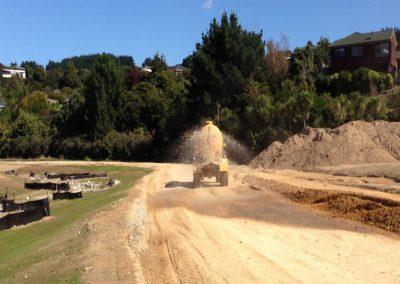
Dust suppression using a water cart (Source: SouthernSkies Limited).
-
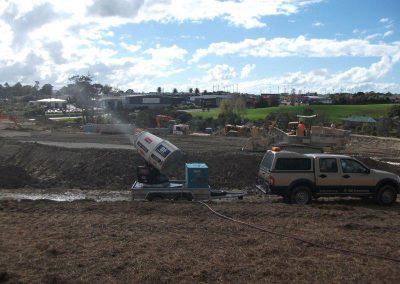
Mist blowing machine providing dust control during a liming operation. This technique can be used on a range of high risk activities (building demolition, unloading hoppers) and also for broad area control (Source: HEB Construction).
Mulching, grass establishment and gravelling (progressive stabilisation)
You can use surface mulching as a temporary mulch (eg straw) to cover potentially-dusty stockpiles or other areas that will not be worked for an extended period. Otherwise, it can be progressively applied alongside with permanent revegetation works. Gravelling the compound areas, haul roads and access tracks will extend your coverage of the site.
Temporary vegetative cover can be used on stockpiles or other areas not worked for an extended period. Otherwise permanent vegetative cover can be progressively applied to completed areas. Vegetation will reduce wind velocity at ground level and stabilise the surface.
There is more detailed information in our sections on mulching and grass establishment if needed.
Construction, operation and maintenance
When constructing dust controls
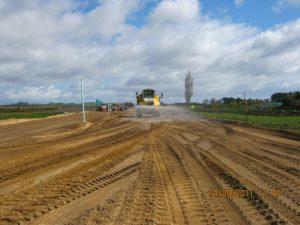
Water cart dampening down the open area—use a wetting agent with the water to increase the tool’s efficiency and effectiveness (Source: Fulton Hogan).
- During periods of low moisture conditions, apply enough water to prevent dust generation without causing runoff.
- Once areas are damp enough to prevent dust generation, regularly apply enough water to replace that lost through evaporation.
This will often be an ongoing operation, especially over windy or dry periods.
Where dust suppressants, ‘sealing off’ areas or isolating areas are used as control measures, adequate controls are needed to isolate these areas from construction traffic or activities. This may include fencing, signage or bunding.
When operating dust controls
For a full description of recommended management practices in controlling dust, see the Ministry for the Environment’s (2001) Good Practice Guide for Assessing and Managing Dust. Common practices are to:
- Minimise the area of soil exposed to the wind by staging works across the site
- Limit traffic to established haul roads and optimise the site layout to minimise travel distances
- Control vehicle speeds
- Maintain the surface of roads
- Minimise the dirt that is being tracked out on vehicle wheels onto paved surfaces (see stabilised entranceways)
- Minimise drop heights when loading and unloading vehicles
- Use a mist generating machine when loading and unloading vehicles
- Limit the height of stockpiles
- Shelter stockpiles from the wind
- Cover unstabilised surfaces and stockpiles with mulch, binders or vegetation
- Consolidate loose surface material.
When maintaining dust controls
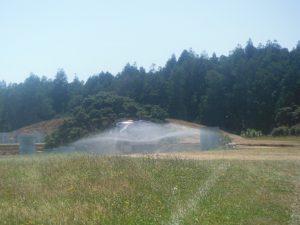
Using a water cart to wet a haul road—use a wetting agent with the water to increase the tool’s efficiency and effectiveness (Source: SouthernSkies).
- Monitor dust emissions at least daily. In windy dry conditions, review dust emissions continuously. If you see dust discharges, evaluate whether the methods you are using are effective or need to be improved or adapted to give effective control.
- Reapply water as required to effectively manage levels of dust generation, especially when soil moisture conditions become low during hot and windy conditions.
